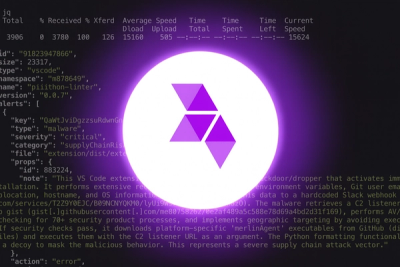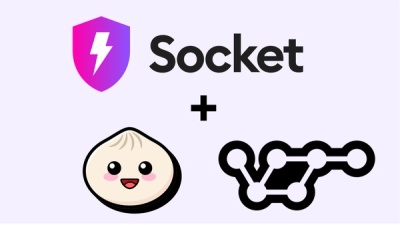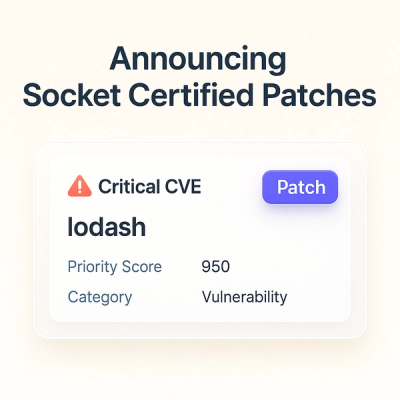
Product
Introducing Socket Scanning for OpenVSX Extensions
Socket now scans OpenVSX extensions, giving teams early detection of risky behaviors, hidden capabilities, and supply chain threats in developer tools.
@clocklimited/darkroom-url-builder
Advanced tools
A module that builds URLs for your darkroom resources.
npm install @clocklimited/darkroom-url-builder
yarn add @clocklimited/darkroom-url-builder
var createDarkroomUrlBuilder = require('@clocklimited/darkroom-url-builder')
Returns a function that creates URL builder instances. darkroomHost{s} and salt
are required, as these are both used in the composition of the URLs.
If multiple darkroom hosts are provided (as an array), a round-robin approach to url generation will be used. See round-robin-hosts for more info.
Create a new URL builder instance. Every time you want to build a new URL, you start with this function.
Set the resource you want a URL for. This is the URI that darkroom gave you when you posted or cropped your asset.
Returns b for chaining.
Set the width of the asset you want to receive.
Returns b for chaining.
Set the height of the asset you want to receive.
Returns b for chaining.
Set the quality of the asset you want to receive.
Returns b for chaining.
Set the direction that the image gravitates to. Should be one of:
NorthWest, North, NorthEast, West, Center, East, SouthWest, South, SouthEast
Returns b for chaining.
Set the filename of the asset you want to receive. This is for vanity of the URL and has no bearing on the response format or content-type headers.
Returns b for chaining.
Builds a URL pointing to the resource described by the combination of width, height
filename settings. If width and height are not set, the URL will point to the original
resource, otherwise it will be constrained in one or both dimensions.
Note that darkroom will not distort the resource beyond its original aspect ratio. If you set
width and height to something other than the original aspect ratio, you have no control of
what part of the image is cropped. You should use the darkroom cropping API to create a new resource
and create a URL for that instead.
Darkroom will only constrain images to the dimensions, it will not upscale. e.g.: if the original resource is 400px wide, asking for an 800px will return an image no bigger than 400px.
Builds a URL that points to a JSON endpoint describing the resource's dimensions.
var createDarkroomUrlBuilder = require('darkroom-url-builder')
, builder = createDarkroomUrlBuilder('http://darkroom.io', 'salty')
var thumb = builder()
.resource('00000000000000000000000000000000')
.width(100)
.filename('test.jpeg')
.url()
console.log(thumb)
//-> http://darkroom.io/100/00000000000000000000000000000000:2f314341b9d1d41f1b54b07be8d0cd1a/test.jpeg
var original = builder()
.resource('00000000000000000000000000000000')
.filename('test.jpeg')
.url()
console.log(original)
//-> http://darkroom.io/original/00000000000000000000000000000000:9f847ee652ef4eed45a39625ef30193f/test.jpeg
var info = builder()
.resource('0b8bafa96885483bc2778976a514334e')
.info()
console.log(info)
//-> http://darkroom.io/info/0b8bafa96885483bc2778976a514334e:bc2afc01898e3b8e2613793be6cd7598
If you are looking to improve your page speed but have quite a few darkroom assets slowing you down, you may have seen advice such as the following from the various page speed tools:
Parallelize downloads across hostnames
This page makes xx parallelisable requests to darkroom.domain.com. Increase download parallelization by distributing these requests across multiple hostnames
In order to achieve this with darkroom url builder, you can simply pass in a list of darkroom hosts for it to use. For each url generated it will use the subsequent item in the list as the hostname, looping back to the first item when the list is exhausted. For example:
var urls = [ 'http://darkroom1.io', 'http://darkroom2.io', 'http://darkroom3.io' ]
, builder = createDarkroomUrlBuilder(urls, 'test salt')
builder()
.resource('uid')
.height(100)
.width(100)
.filename('jim.jpeg')
.url() //-> http://darkroom1.io…
builder()
.resource('uid')
.height(100)
.width(100)
.filename('jim.jpeg')
.url() //-> http://darkroom2.io…
builder()
.resource('uid')
.height(100)
.width(100)
.filename('jim.jpeg')
.url() //-> http://darkroom3.io…
builder()
.resource('uid')
.height(100)
.width(100)
.filename('jim.jpeg')
.url() //-> http://darkroom1.io…
Obviously the DNS work to get all of the hosts pointing the same darkroom instance is up to the user.
darkroom-url-builder also comes with a tiny command line application to save you from having to spin
up a node REPL to get the URL of an image.
darkroom-url-builder darkroomUrl salt uri$ darkroom-url-builder http://0.0.0.0:17999 salt f113b531524b64968a21be183307c7b7
http://0.0.0.0:17999/original/f113b531524b64968a21be183307c7b7:70615591bd5472c9a9ffff9396b7ba20
Run the tests with npm test. Generate a coverage report with npm test --coverage.
FAQs
Build URLs for darkroom resources
We found that @clocklimited/darkroom-url-builder demonstrated a not healthy version release cadence and project activity because the last version was released a year ago. It has 5 open source maintainers collaborating on the project.
Did you know?

Socket for GitHub automatically highlights issues in each pull request and monitors the health of all your open source dependencies. Discover the contents of your packages and block harmful activity before you install or update your dependencies.

Product
Socket now scans OpenVSX extensions, giving teams early detection of risky behaviors, hidden capabilities, and supply chain threats in developer tools.

Product
Bringing supply chain security to the next generation of JavaScript package managers

Product
A safer, faster way to eliminate vulnerabilities without updating dependencies